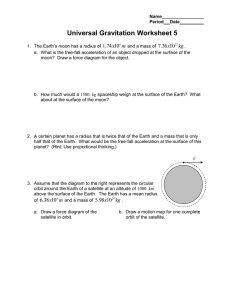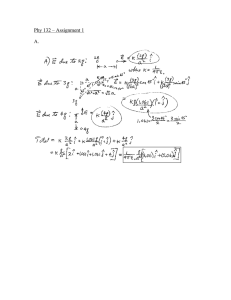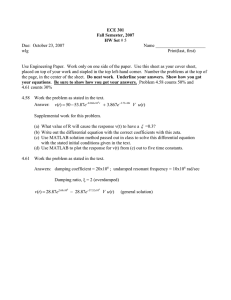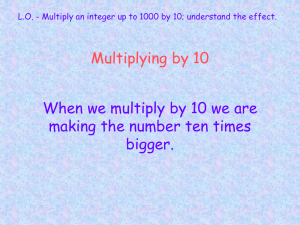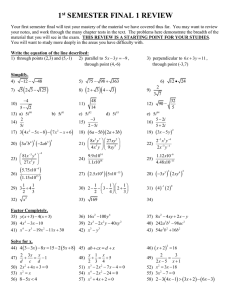Orbital Motion
advertisement
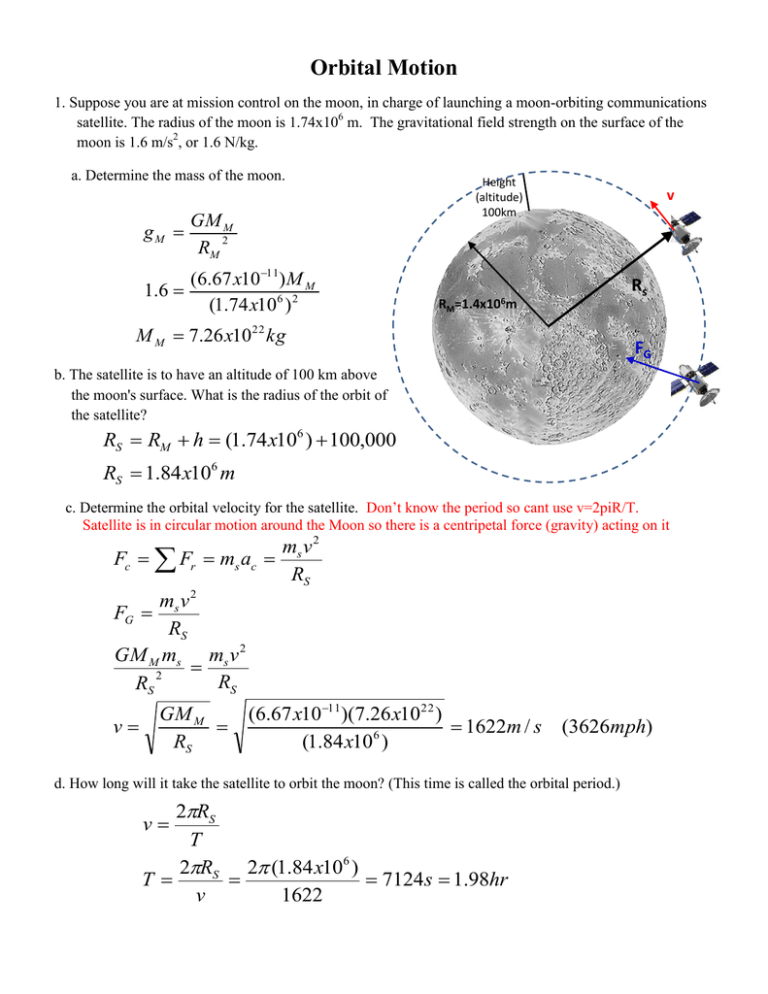
Orbital Motion 1. Suppose you are at mission control on the moon, in charge of launching a moon-orbiting communications satellite. The radius of the moon is 1.74x106 m. The gravitational field strength on the surface of the moon is 1.6 m/s2, or 1.6 N/kg. a. Determine the mass of the moon. gM GM M 2 RM (6.67 x10 11) M M 1.6 (1.74 x106 ) 2 Height (altitude) 100km v Rs RM=1.4x106m M M 7.26 x10 22 kg FG b. The satellite is to have an altitude of 100 km above the moon's surface. What is the radius of the orbit of the satellite? RS RM h (1.74 x106 ) 100,000 RS 1.84 x106 m c. Determine the orbital velocity for the satellite. Don’t know the period so cant use v=2piR/T. Satellite is in circular motion around the Moon so there is a centripetal force (gravity) acting on it ms v 2 Fc Fr ms ac RS ms v 2 FG RS GM M ms ms v 2 2 RS RS v GM M RS (6.67 x10 11)(7.26 x10 22 ) 1622m / s (1.84 x106 ) (3626mph) d. How long will it take the satellite to orbit the moon? (This time is called the orbital period.) 2RS T 2RS 2 (1.84 x106 ) T 7124s 1.98hr v 1622 v 2. The space shuttle aims for an orbit about 500 km above the surface of the earth. The mass of the space shuttle is about 95,000 kg. The radius of the earth is approximately 6.38 x 106 m. Height (altitude) 500km a. Determine the mass of the Earth. GM E gE 2 RE (6.67 x10 11) M E 9.8 (6.38 x106 ) 2 v Rs RE=6.38x106m M E 5.98 x10 24 kg b. Calculate the orbital speed of the space shuttle. Shuttle is in circular motion around the Earth so there is a centripetal force (gravity) acting on it FG ms v 2 Fc Fr ms ac RS ms v 2 FG RS GM E ms ms v 2 2 RS RS GM E RS v (6.67 x1011)(6 x10 24 ) 7627 m / s (6.38 x106 500,000) (17,061mph) c. Calculate the orbital period of the space shuttle. 2RS T 2RS 2 (6.88 x106 ) T 5665s 1.57hr v 7627 v 3. The earth's orbit around the sun is very nearly circular, with an average radius of 1.5 x 1011 m. Assume the mass of the earth is 6 x 1024 kg and the mass of the sun is 1.99×1030kg a. Determine the average speed of the earth in its orbit around the v sun. m v2 Fc Fr mE ac E R 2 mE v R GM S mE mE v 2 R2 R GM S (6.67 x10 11)(1.99 x1030 ) v R (1.5 x1011) 29,747 m / s (66,542mph) FG R=1.5x1011 FC=FG b. What is the magnitude of the earth's average acceleration in its orbit around the sun? v 2 29747 2 aC 0.0059m / s 2 11 R 1.5 x10 (0.06% g ) c. Determine the gravitational force on the earth by the sun. How does the force on the earth by the sun compare to the force on the sun by the earth? GM S mE (6.67 x1011)(1.99 x1030 )(6 x1024 ) FG 3.54 x1022 N 2 11 2 R (1.5 x10 ) Direction is towards the Sun. rd Force on the Sun by the Earth is equal and opposite (Newton’s 3 Law) FG, Earth, Sun = - FG, Sun, Earth = 3.54 x 1022N towards the Earth 4. The National Academy of Science, in order to gather information on deforestation, wishes to place a 500 kg infrared-sensing satellite in a polar orbit around the earth. The radius of the earth is approximately 6.38 x 103 km, and the acceleration of gravity at the orbital altitude of 160 km is very nearly the same as it is at the surface of the earth. a. Determine the orbital speed of the satellite as it orbits the earth. Don’t know the period so cant use v=2piR/T. Shuttle is in circular motion around the Earth so there is a centripetal force (gravity) acting on it Height (altitude) v 160km Rs RE=6.38x106m FG First, you need the mass of the Earth since it was not given. ms v 2 Fc Fr ms ac RS ms v 2 FG RS GM E ms ms v 2 2 RS RS v GM E RS gE GM E 2 RE (6.67 x10 11) M E 9.8 (6.38 x106 ) 2 M E 5.98 x10 24 kg (6.67 x10 11)(5.98 x10 24 ) 7810m / s 6 (6.38 x10 160,000) (17,470mph) b. Determine how long it would take for the satellite to make one complete revolution around the earth. 2RS T 2RS 2 (6.54 x106 ) T 5259s 1.46hr v 7810 v 5. A geosynchronous orbit is one in which a satellite in that orbit appears to be stationary relative to a point on the earth. In other words, it completes one orbit in the same time the earth takes to rotate about its axis, 24 hrs. Calculate the height of a satellite in a geosynchronous orbit. Use data for the earth’s radius and mass from the previous problems. h Orbital radius is R = RE + h For a geosynchronous satellite, T = 24 hrs = 86,400 s ME = 5.98 x 1024 kg RE = 6.38 x 106 m ms v 2 R 2 2 mv m 4 R FG s s 2 R T GM E ms ms 4 2 R R2 T2 GM ET 2 (6.67 x10 11)(5.98 x10 24 )(86400 2 ) 3 R 4 2 4 2 R 42.2 x106 m Fc Fr ms ac R RE h h R RE (42.2 x106 ) (6.38 x106 ) 35.8 x106 m 5.6 RE 6. Astronomers using the Hubble Space telescope have recently deduced the presence of an extremely massive core in the distant galaxy M87, so dense that it could well be a black hole (from which no light escapes). They did this by measuring the speed of gas clouds orbiting the core to be 780 km/s at a distance of 60 light years (5.7 x 1017 m) from the core. Deduce the mass of the core and compare it to the mass of our Sun (2 x 1030 kg). Fc Fr mgasac FG mgasv M core mgasv 2 An artist's concept shows the supermassive black hole in the heart of M87. The black hole is in the center of the orange disk. The disk itself is made of hot gas spiraling into the black hole. Powerful magnetic fields funnel some of the particles in the disk into jets (left and right of the disk) that extend hundreds of thousands of light-years into space. As the particles spiral through the magnetic fields, they emit radio 17 waves. R v R (780,000) 2 (5.7 x10 ) G 6.67 x10 11 5.20 x1039 kg 2.6 x109 M Sun 2.6 billion x M sun 2 M core R 2 R GM Coremgas R2 mgasv 2 7. Find the centripetal acceleration for each of the following: (a) a point on the earth’s equator (ignore its orbital motion) (radius of Earth=6.38x106 m) period of earth’s rotation is 1 day = 86,400s v 2 4 2 RE 4 2 (6.38 x106 ) ac 0.034m / s 2 0.0034 g 2 2 r T 86400 (b) the earth in its orbit around the sun (radius = 1.49x1011 m) period of earth’s rotation around sun is 1 year = 3.156 x 107 s v 2 4 2 R 4 2 (1.49 x1011) ac 0.0059m / s 2 0.00059 g 2 7 2 r T (3.156 x10 ) (c) the sun’s orbit around the center of the Milky Way (period = 2 x108yrs; radius = 3 x1020 m) period of earth’s rotation around center of galaxy is 2x108 year = 6.31 x 1015 s v 2 4 2 R 4 2 (3x1020 ) ac 3.0 x1010 m / s 2 3.0 x1011 g 2 15 2 r T (6.31x10 ) 8. Here is the data for the space shuttle in its orbit around earth: Shuttle mass in orbit, ms = 94,802 kg mass of the earth ME = 6 x 1024 kg shuttle orbital height above the earth = 2.76 x 105m radius of the earth = 6.38 x106 m shuttle tangential velocity when in orbit vt = 7823 m/sec a. Use the principles of circular motion to find the centripetal force necessary to keep the shuttle in its circular orbit around earth. mvt2 FC Fr mac 2 Rs (94802)(78232 ) (6.38 x106 0.276 x106 ) 8.72 x10 N 5 vT=7823m/s Height (altitude) 2.76x105m Rs RE=6.38x106m b. Use Newton’s Law of Universal Gravitation to find the gravitational force the earth exerts on the shuttle when the shuttle is in orbit. FG FG GM E ms 2 RS (6.67 x10 11)(6 x1024 )(94802) 5 8 . 56 x 10 N (6.656 x106 ) 2 Direction is towards the center of the Earth c. How do the values calculated in parts a and b compare to one another? Explain. Fc > FG by about 2%. The shuttle speed is a little more than that to be in stable circular orbit so shuttle is probable in an elliptical orbit. Moreover, there are other gravitational forces from other objects much farther away such as the moon, the sun and other planets and these would also affect the centripetal force on the shuttle in a minor way.
